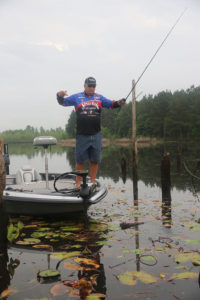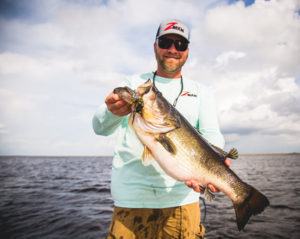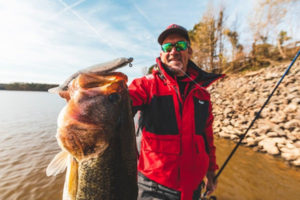July Bass at Lake Seminole
with Daryl Davis
Big bass in shallow grass, even in July. If that sounds like a good pattern to you, plan to head south to Seminole this month. The hydrilla has grown thick on river ledges and the bass move into it to feed. You can catch some bragging size stringers right now fishing the grass at Seminole.
Seminole is an impressive 37,500 acre lake right in the corner of Georgia, Florida and Alabama. This time of year half its surface can be covered with hydrilla, making it look like a fantastic place to catch bass. And it is, but if you go out casting to all the hydrilla you may never get bit. The bass hold in specific areas that you will have to learn.
Although the heat can be oppressive this time of year, and the hydrilla gnats will drive you crazy if there is no breeze, you can catch bass all day long out of the thick cover if you fish it right. Early mornings and late afternoons are still best, but big bass will hit in the middle of the day, too.
Daryl Davis lives in Ochlocknee, near Thomasville, where he runs a family owned grocery store and fishes with the Rose City Bassmasters. He has been with that club for about 12 years and they fish Seminole often. This year Daryl made the state team at the Top Six tournament on Eufaula.
For several years Daryl has fished the BFL trail, the Georgia/Florida Team trail and other local tournaments on Seminole. He has learned its secrets and knows where to go to catch bass every month. He agreed to show me his July patterns and some places where they work. We spent an afternoon on the lake on June 17 and landed several bass, including a 3.5 pounder I caught and a 5 pound fish he caught.
Hydrilla is the key but the bottom structure where it grows controls where the fish will be in it. Bass hold in deeper water this time of year, so hydrilla edges near channels are the best place to find them. They will move up ditches across hydrilla flats to feed, too, but you need some kind of bottom contour to attract them to an area.
First thing in the morning Daryl likes to start off with topwater baits for the early bite. He will throw a black or white skirted buzzbait and run it across the hydrilla edges and around clumps of the grass. A chrome and black Pop-R is also a good bait when the bass want something moving a little more slowly.
About an hour after the sun gets above the trees Daryl will try a 3/16 or 1/4 ounce double willowleaf white spinnerbait with chrome blades. This bait is run above the hydrilla and dropped into cuts and holes in the grass. The bass will often slam it as it flutters down past them.
A Carolina rigged Zoom Mag 2 or Ultravibe in Junebug red or green pumpkin is a good bait for some areas. If the grass is scattered enough to drag it effectively, Daryl will rig up with a half-ounce lead and cover flats around ditches with it. He also likes to cast it to brush piles in deeper water.
A Bandit crankbait works well when the hydrilla is thin enough to work it around clumps of grass or over it. Daryl will fish a crankbait along the edge of the hydrilla and over the flats when he can. That allows him to cover more water and find active fish.
Daryl’s go-to bait is a Texas rigged Baby Brush Hog or Mag 2 worm in Junebug red or green pumpkin. He uses a 3/16 to 5/16 Florida sinker ahead of the bait. These sinkers have a screw eye that will hold them to the worm so you don’t need to peg it. This bait is dropped into holes, cuts and points in the hydrilla to attract bass all day long.
Heavy equipment is needed to drag big bass out of the grass, and Daryl uses 17 to 20 pound clear Sensation or Silver Thread line. A stiff rod helps drag the bass and grass to the boat when the fish burrows down into it, and he often cranks down the drag on his bait casting reels till it won’t slip.
The following ten spots all hold bass and we caught fish on several of them two weeks ago. Check them out and then you will be able to find many more just like them.
1. N 30 47.356 – W 84 40.990 – Up the Flint River above Wingates near Faceville Landing you will go past an island on your right running upstream. It is just downstream of the place the channel goes to the right bank below Faceville. On the upstream end of the island is a red channel marker. A ledge runs from the island out past this channel marker, parallel to the channel.
There are some brush piles on the point around the marker in about 16 feet of water. This is a good place to cast a Carolina rig and probe the point and brush since July bass hold in and around it. Fish all around the marker, casting toward it from a big circle. You can also ride the point with a good depthfinder and mark the brush. When you locate the brush make repeated casts to it. Current running into the brush helps.
2. N 30 47.367 – W 84 42.011 – Downstream of the island Butler Creek enters on your left going downstream. The downstream point of it has a good hydrilla edge to fish. A flat runs out to the channel and you will see a group of 5 stumps and a sixth one a little away from them. Bass hold out on the channel and run in to the grass to feed.
Start fishing the hydrilla edge at the point of Butler Creek and work downstream. Early in the morning try topwater along the edges and give the spinnerbait a try. Then pitch or flip a Baby Brush Hog or Mag 2 worm to the edge of the grass. Concentrate on cuts, holes and points in the hydrilla. Bass will hold on any irregularity.
Try to make the bait enter the water without a ripple first. When the bass are holding shallow sometimes a loud splash will spook them. At other times Daryl says a loud splash seems to attract them, so try that if the quiet entry is not working. In either case, expect a hit on the fall. When your bait hits bottom, twitch it once or twice then pick it up to make another flip.
If the day is cloudy and early in the morning Daryl says the bass are more likely to be roaming the outside edge of the grass. When the sun gets on the water it tends to make them back up into the cover, holding inside the grass. That is when you must make your bait fall right beside the grass and pitching into holes back in the grass is more likely to pay off.
3. N 30 47.307 – W 84 42.831 – Head downstream and the channel will kick back to the left a little. Just before it goes into the sharp right bend, around the last green marker before the bend, start fishing the grass on your right. You will be across the channel from two tall sanding trees out in the water. This grass is just off the channel and the big flat behind it is full of stumps and thick grass.
The bass will hold along this grass edge, moving up out of the nearby channel to feed. Fish all along this edge, working all the way down to where the channel bends. Current moves parallel to the grass so any little point or pocket in the grass is a good holding place for bass to ambush food.
4. N 30 47.407 – W 84 43.169 – Head downstream and the channel makes a sharp sweeping turn all the way across the lake to the right bank. The outside bend of the channel drops off sharply and there is a huge grass flat running all the way past Wingates. Many bass move off this flat in the summer and hold on the outside bend.
Watch for a big stump on your left that sits right on the channel. It will be even with the green channel marker across the channel and about half-way between two red markers. There is a shallow ditch that runs across the flat at an angle, running to your right and downstream if you are facing downstream. You can see it as an opening in the grass and stumps. Start fishing near that stump.
Fish the main channel edge but also fish down the ditch, pitching to grass on both sides of it. The water in the ditch will be 7 to 9 feet deep and each end drops off into the channel. This is a big area to work since you have the outside edge of the river channel all the way around the bend and both sides of the ditch.
It was near the downstream end of this ditch, but back on the main river channel, that I caught a 3.5 pound bass on a green pumpkin Baby Brush Hog two weeks ago. The bass thumped the Brush Hog as it fell then headed straight to the boat with it. When you feel a bite, set the hook fast, the bass often run to deep water as soon as they hit. Daryl also caught a couple of bass in this area.
5. N 30 47.578 – W 84 43.363 – On the right going downstream where the river hits the bank a big cove full of cattails sits off the edge of the water. About 100 yards downstream is the entry to Ten Mile Still Landing. Look at the grass and you will see a point on it. This grass is on a sandbar that runs out toward the channel.
Fish the grass edges all around this point and also work the point with a Carolina rig and a crankbait. Bass will use the sandbar to move out of the channel to the grass to feed, and will feed on the sandbar, especially when there is current flowing across it.
6. N 30 45.721 – W 84 46.216 – Run down past Wingates to where the channel swings back to the left bank. You will see some docks on the bank and one has a green roof on it. Go in toward that dock and you will be crossing a big grass flat that runs from the channel to the bank. Upstream of this dock is a small creek that enters the lake and there is a lot of sand on the bottom in this area.
Start fishing out in front of the green roofed dock and fish the flat, working upstream. Daryl likes to cast a crankbait here, running it above the grass if it is still deep enough or around the clumps of grass growing here. Daryl got a keeper bass here when we fish together. The bass can be anywhere on this flat so you need to cover all of it. If you catch a bass on the crankbait, stop and fish slower with either a Carolina or Texas rig since there should be more nearby.
7. N 30 45.811 – W 84 50.156 – The next spot Daryl calls “Stinky Island” because of the birds roosting and nesting there. It is the last big island before the channel to Sealey Point. You can run down the marked channel to the Sealey channel then go upstream to the island, or you can cut across and run the right bank if you know how to avoid the stumps.
There is a huge grass bed off the bank of this island on the Flint River side. There is also a ridge of grass off the bank here. Fish both grassbeds, fishing all along the edge on the island and then the one out further that runs parallel to it. If you are here early in the morning try topwater and spinnerbaits. After the sun gets up fish the grass edges with plastic baits.
8. N 30 47.382 – W 84 55.679 – Sometimes the Chattahoochee River is better that the Flint, often because of current moving there. The next three spots are up the “Hooch” and a long run from Wingates, but convenient to Land’s End Marina. If you are coming upstream from the dam, you will enter the channel behind a long ridge of an island between the channel and the huge flat toward the Florida shoreline.
Watch for the first gap to your left running up the river. The downstream point is an excellent place to catch bass. There will be some hydrilla patches near the bank to fish and out on the point is some rock and brush. Daryl likes to fish the shallow grass then set up inside the cut and cast out onto the point if current is moving across it.
Work a Carolina rig on the point and probe for the cover on it. Fish all around the point if there is no current, but fish with the current if any if moving. Current really makes the bass bite better and Daryl says he has hung some big bass here.
9. N 30 47.716 – W 84 55.679 – Run on up almost to the cut to Land’s End and watch for a big opening on your right. The point on the downstream side of this cut runs out as a ledge parallel to the channel and has some stumps on it. Daryl fishes the grass around the point into the cut and then casts across the point with a Carolina rig. He says he lost one of the biggest bass he ever hooked here.


